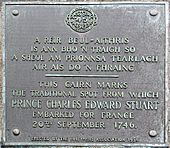Prince's Cairn facts for kids
Quick facts for kids Prince's Cairn |
|
|---|---|
|
Càrn Prionnsa
|
|

The Prince's Cairn by the Loch nan Uamh
|
|
| General information | |
| Type | cairn |
| Location | Beasdale |
| Coordinates | 56°53′42″N 5°44′43″W / 56.89495°N 5.74517°W |
| Inaugurated | 4 October 1956 |
| Client | 1745 Association |
| Technical details | |
| Material | Stone |
The Prince's Cairn is a special stone monument in Scotland. It marks the exact spot where Prince Charles Edward Stuart left Scotland for France. This happened on September 20, 1746. He was leaving after his attempt to take the British throne failed. This attempt was called the Jacobite rising of 1745.
The cairn (a pile of stones used as a monument) is on the shores of Loch nan Uamh. This is a lake in an area called Lochaber. The 1745 Association built it in 1956. This group works to remember and protect the history of the Jacobite period.
The cairn remembers the Prince's final departure. But Loch nan Uamh is also where he first arrived in Great Britain. This was on July 25, 1745. It's also where he escaped to the Hebrides islands in April 1746. This was after his army lost the Battle of Culloden.
Contents
Remembering Prince Charles Edward Stuart
On October 4, 1956, a special event took place. The 1745 Association held a ceremony. They were unveiling the new cairn. This cairn marked the place where Bonnie Prince Charlie left for France.
Over 200 people gathered for the event. They stood on a small piece of land by the loch. The new cairn was built using money from donations. It was covered with the Scottish flag. Flags of the clans who supported the Jacobite cause were also there. The Jacobite cause was the effort to put Prince Charles's family back on the throne.
The Unveiling Ceremony
The ceremony was led by important people. These included Diana Hay, 23rd Countess of Erroll. She was Scotland's Lord High Constable. This is a very old and important role. Also present was Sir Donald Hamish Cameron of Lochiel. He was the chief of Clan Cameron. Other leaders and their families were there too. It was interesting that the last time a woman held the Lord High Constable role was during the 1745 rebellion.
When the Countess uncovered the cairn, the builder played music. John MacKinnon of Arisaig played a piobaireachd on his bagpipes. This is a special type of Scottish bagpipe music. Then, famous piper Angus MacPherson joined him. He played a sad, traditional song called a lament. MacPherson was related to a piper who hid with Prince Charles. They hid in a secret place called the "Cage" near Ben Nevis.
What the Cairn Looks Like
The cairn is made from stones found nearby. It has a metal plaque with words on it. The words are in both Gaelic and English.
The Gaelic words say:
- A reir beul-aithris is ann bho 'n tràigh so an sheòl Am Prionnsa Tearlach air ais do 'n Fhraing.
The English words say:
- This cairn marks the traditional spot from which Prince Charles Edward Stuart embarked for France.
-
- 20th September 1746.
The cairn stands on a small point of land. It is right next to the A830 road. This road is also known as the Road to the Isles. You can park your car nearby in a large pull-off area. The closest train station is Beasdale. It is about 2.5 miles (4 km) to the west.
Prince Charles's Journeys to Loch nan Uamh
Loch nan Uamh was important for Prince Charles's journey. He arrived there, escaped from there, and finally left from there.
Arriving in the Highlands
Prince Charles first arrived in Scotland on July 23, 1745. He sailed on a ship called the Du Teillay. This ship was a privateer, meaning it was a private ship allowed to attack enemy ships. He landed on Eriskay island with seven friends. After one night, they sailed to Loch nan Uamh. This was where Prince Charles first stepped onto mainland Britain.
He then stayed at a farm on Skye. On July 29, he crossed the Sound of Arisaig back to the mainland. In August, he officially started the rebellion. He raised his flag at Glenfinnan in the Scottish Highlands. This began the '45 Rising.
Escaping After Culloden
On April 26, 1746, Prince Charles was defeated. This was at the Battle of Culloden. Ten days later, he had to escape. He and his companions set out from Loch nan Uamh by boat. They were heading for the Hebrides islands.
The weather was terrible. The boat started to fill with water. Even the experienced sailor thought they were lost. The Prince told them to bail out the water instead of just praying. The next morning, they managed to reach a small bay on Eriskay.
Leaving for France
On September 19, 1746, Prince Charles returned to Loch nan Uamh. He had spent five months hiding from government troops. He had been in a secret refuge called "Cluny's Cage" on Ben Alder. He was with Donald Cameron of Lochiel and others.
At Loch nan Uamh, they found a French ship called L'Heureux. This ship was there to take him to safety. Throughout September 19, his supporters boarded the ships. The next day, the ships sailed from Scotland. Prince Charles, known as the Young Pretender, never returned to Scotland. He died in Rome in 1788.


